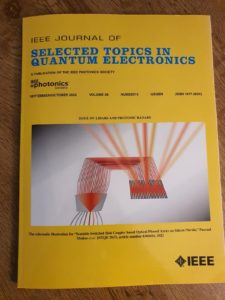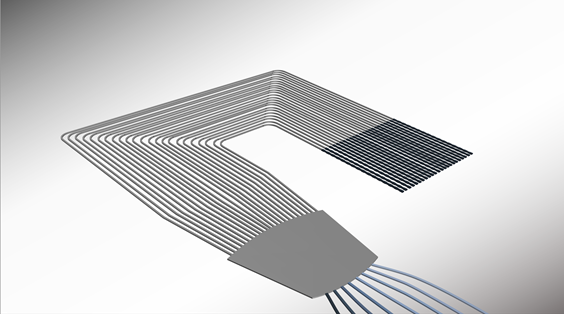The paper produced at the Photonics Research Labs-iTEAM in collaboration with Xanadu Quantum Technologies Inc and titled “Scalable Switched Slab Coupler Based Optical Phased Array on Silicon Nitride“, recently published in the Journal of Selected Topics on Quantum Electronics (JSTQE) of IEEE Photonics Society, got the cover of the special issue on LIDARS and Photonic Radars.
 In this paper, the authors proposed a step towards a LIDAR (Light detection and ranging) chip on a car for capturing the relative distances and speeds of the surrounding objects, with an architecture that can be scaled up to meet actual driving conditions. According to main author Prof. Pascual Muñoz, Director at UPVfab Micro-fabrication pilot line, “the photonic chip presented can produce beams of photons in the near-infrared and steer them along the scene by means of a tunable laser diode. The chip architecture incorporates switches that allows addressing a selected part of the scene (random access)”. The photonic chip can also adopt different resolutions to image different parts with coarser or finer detail (adjustable resolution). Finally, the architecture can be configured to outline large objects (object framing).
In this paper, the authors proposed a step towards a LIDAR (Light detection and ranging) chip on a car for capturing the relative distances and speeds of the surrounding objects, with an architecture that can be scaled up to meet actual driving conditions. According to main author Prof. Pascual Muñoz, Director at UPVfab Micro-fabrication pilot line, “the photonic chip presented can produce beams of photons in the near-infrared and steer them along the scene by means of a tunable laser diode. The chip architecture incorporates switches that allows addressing a selected part of the scene (random access)”. The photonic chip can also adopt different resolutions to image different parts with coarser or finer detail (adjustable resolution). Finally, the architecture can be configured to outline large objects (object framing).
The photonic chip was manufactured in state-of-the-art CMOS-compatible foundry, using silicon-based technology. Hence, the device reported is amenable for mass manufacturing, a very relevant aspect to meet automotive market expected demand for LIDAR. However, the new work highlighting silicon needs to be complemented with other materials to be able to meet all application requirements. In particular, the reported LIDAR chip has a limited reach estimated of a few meters, while most demanding scenarios such as highway driving require reach of a few hundred meters. Silicon needs then to be complemented with III-V materials for such purpose (producing more photonics, thus extending reach in LIDAR applications).
“PIC technologies, based on silicon, III-V semiconductors and other materials, and their combination (so-called hybrid integration) are maturing at a pace where LIDAR in cars could be a reality by 2030” stated Dr. Gloria Micó, Facility Manager at the UPVfab . This work outlined and detailed the proposed hybrid integration to incorporate such optical amplifiers to the LIDAR chip, and how the reach could be then extended to meet the demanding scenarios.
Prof. Pascual wanted also to remark that this achievement could not have been obtained without the collaboration of the rest of authors: Prof. Daniel Pastor, Dr. Gloria Micó and Dr. Luis A. Bru from PRL, Dr. Jesús Benítez from iPronics Programmable Photonics, Dr. Dominic Goodwill (Principal Photonics Engineer at Xanadu), and Eric Bernier (Leader of Advanced Photonic at Huawei Technologies CO Ltd).

